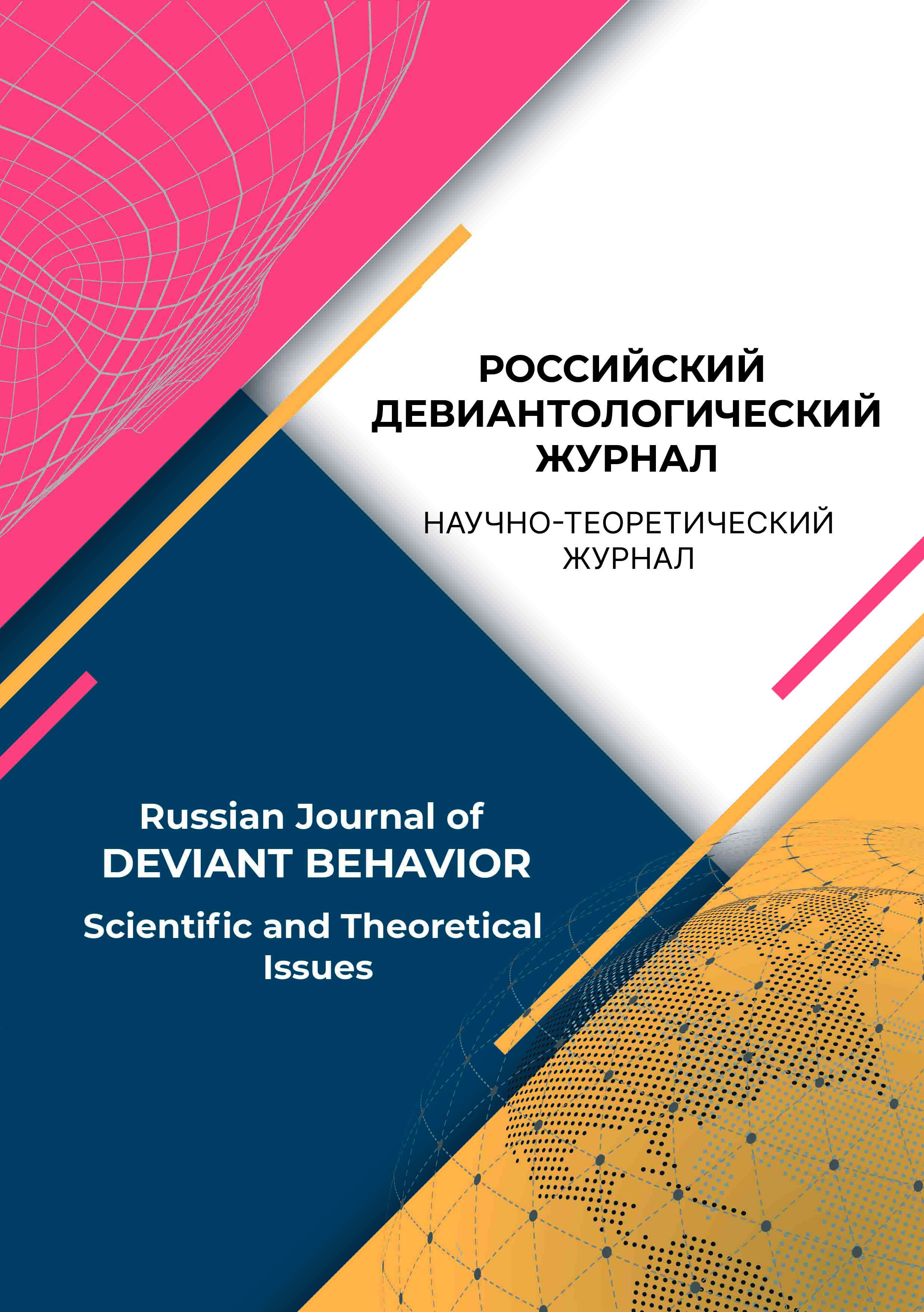UDC 159.9
UDC 316.624
Introduction. The study of religious radicalisation is an important aspect of counteracting the incitement of hostility between different groups and communities and reducing the level of violence in Russian society. Modern scientific ideas are characterised by multiple meanings that do not effectively counteract the negative impact on young people’s attitudes towards religion and the believers. Academic literature describes concepts and models of radicalisation that differ in theoretical and methodological foundations, based mainly on the material of foreign studies. This situation makes it impossible to develop a construct of radicalisation that could be operationalised for diagnosing the risk of religious radicalisation of Russian youth. The purpose of the research is to verify the theoretical model (construct) of religious radicalisation, as well as to develop a questionnaire based on it, which makes it possible to measure the risk of religious radicalisation of young people through the study of attitudes towards religion and believers. It is supposed that religious radicalisation is formed under the influence of the social environment on the subject’s perceptions of the importance of religion and believers for society and the state. Based on the analysis of theoretical knowledge about radicalisation, facts and information about the activities of destructive religious and extremist communities, a model of religious radicalisation is proposed, including six statements: about the exclusive importance of religion, religious leaders and believers (sacralisation and clericalisation), the need to protect them from changes, interference of non-believers or representatives of another religion (fundamentalism and xenophobia), to maintain relations only with representatives of a particular religious association, including in matters of education, cultural and social development, ignoring or failing to comply with obligations, laws and regulations (socialisation and discrimination). Methodology, methods and techniques. The methodological basis of the research is the socio-psychological approach in the study of human cognition of society (G.M. Andreeva), empirical concepts of religious radicalisation of individuals and groups (A.W. Kruglanski, N. Ellemers, A. R. Schmidt, etc.). The empirical research is aimed at testing the theoretical model of religious radicalisation; development and verification of a questionnaire to study the risk of religious radicalisation. The method of data collection is the questionnaire «Religious radicalisation», structurally corresponding to the theoretical model of radicalisation, including 90 questions grouped into six scales, as well as indicators of religious self-determination and religious behavior. Results processing method: descriptive statistics, correlation, one-factor analysis of variance and confirmatory analysis. Research sample: 874 people divided into Russian (n=336 people), Kyrgyz (268 people) and Uzbek (n=270 people) sub-samples of young people. Results: by means of confirmatory factor analysis of the results of the survey of national samples, the theoretical model of youth radicalisation was corrected. A three-factor empirical model was found to have the best structural characteristics for the Russian sample (χ2=216.5, df=87, p<0.0001, RMSEA=0.067, p=0.008 (RMSEA CI 90% = 0.056-0.078), CFI=0.949, TLI=0.95). The model consists of three scales from the theoretical model (‘Clericalisation’, ‘Discrimination’, ‘Xenophobia’) but includes statements from other scales from the theoretical model (‘Sacralisation’, ‘Fundamentalism’, ‘Socialisation’). The second result was the verification of a questionnaire to study the risk of religious radicalisation among Russian youth. The questionnaire consists of 15 statements, grouped into three scales, has satisfactory reliability values according to the internal consistency criterion and intercorrelations (Cronbach’s α «Clericalisation» = 0.89, r=0.63, p<0.001; «Discrimination» = 0.76, r=0.38, p<0.001; Xenophobia = 0.81, r=0.46, p<0.001). Scientific novelty. The received results expand the idea of socio-psychological preconditions of religious radicalisation, demonstrate a set of beliefs that can stimulate intolerant attitude of young people to religion and believers. Practical significance. The presented methodology can be used for research purposes to study the preconditions of religious radicalisation of young people.
radicalisation, religious extremism, psychology of extremism, radicalisation diagnosis, xenophobia
1. Bovina, I. B., Bovin, B. G., Tihonova, A. D. (2020). Radikalizaciya: social’no-psihologicheskij vzglyad (Chast’ I). Psihologiya i pravo, 10 (3), 120-142. https://doi.org/10.17759/psylaw.2020100309
2. Davydov, D. G., Hlomov, K. D. (2017). Metodika diagnostiki dispozicij nasil’stvennogo ekstremizma. psihologicheskaya diagnostika, 14 (1), 78-97.
3. Zlokazov, K. V., Karayani, A. G., Prokurova, N. S. (2022). Radikalizaciya predstavlenij molodezhi o roli religii v obshchestve metodami kognitivnoj vojny. psihopedagogika v pravoohranitel’nyh organah, 27 (3(90)), 246-256. https://10.24412/1999-6241-2022-390-246-256
4. Karapetyan, A. A., Tagil’ceva, Yu. R. (2017). Princip intolerantnosti kak psihologicheskaya osnova ekstremistskogo diskursa: kommunikativnye taktiki i priemy diskreditacii «vraga». Politicheskaya lingvistika, 6 (66), 235-240.
5. Tagil’ceva, Yu. R., Babikova, M. R., Vatoropin, A. S., Zlokazov, K. V., Latu, M. N., Porozov, R. Yu. (2022). Kognitivnye internet-tekhnologii transformacii social’nogo povedeniya: riski i profilaktika: monografiya. Ekaterinburg: Ural’skij gosudarstvennyj pedagogicheskij universitet. EDN HLAUOV.
6. Kuz’min, A. V. (2009). Fenomen destruktivnosti novyh religioznyh dvizhenij: avtoref. dis. … kand. filos. nauk. Belgorod.
7. Meshcheryakova, A. F. (2021). Rossiya: put’ k svetskosti ili klerikalizacii obshchestva i gosudarstva? Lex russica (Russkij zakon), 74 (10), 85-99. https://doi.org/10.17803/1729-5920.2021.179.10.085-099
8. Pelin, A. A. (2018). Islamskij i hristianskij fundamentalizm v postsekulyarnom obshchestve. Izvestiya Irkutskogo gosudarstvennogo universiteta. Seriya «Politologiya. Religiovedenie», 24, 87-98. https://doi.org/10.26516/2073-3380.2018.24.87
9. Ryaguzova, E. V. (2021). Razryv svyazej v reprezentaciyah vzaimodejstviya YA - Drugoj kak prediktor ekstremistskogo povedeniya. Izvestiya Saratovskogo universiteta. Novaya seriya. Seriya: Filosofiya. Psihologiya. Pedagogika, 21 (1), 78-84. https://doi.org/10.18500/1819-7671-2021-21-1-78-84
10. Stepanova, E. A. (2008). Fundamentalizm i maniya identichnosti. Nauchnyj ezhegodnik Instituta filosofii i prava Ural’skogo otdeleniya Rossijskoj akademii nauk, 8, 94-116.
11. Sityaeva, S. M., Yaremchuk, S. V. (2019). Sub”ektivnye i ob”ektivnye prediktory ekstremistskih ustanovok molodezhi: monografiya. Komsomol’sk-na-Amure: Amurskij gumanitarno-pedagogicheskij gosudarstvennyj universitet.
12. Chepovskaya, A. (2019). Po ayatu na brata: kak sekta iz Kazahstana porabotila umy rossiyan. Izvestiya. URL: https:// iz.ru/883682/anastasiia-chepovskaia/po-aiatu-na-brata-kak-sekta-iz-kazakhstana-porabotila-umy-rossiian.
13. Alavi, M., Visentin, D. C., Thapa, D. K., Hunt, G. E., Watson, R., & Cleary, M. (2020). Chi-square for model fit in confirmatory factor analysis. Journal of Advanced Nursing, 76 (9), 2209-2211. https://doi.org/10.1111/jan.14399.
14. Altemeyer, B. (2009). Why Do Religious Fundamentalists Tend to be Prejudiced? The International Journal for the Psychology of Religion, 13 (1), 17-28. https://10.1207/S15327582IJPR1301_03
15. Bartlett, J., Birdwell, J., & King, M. (2010). The edge of violence: A radical approach to extremism. Demos, 5, 75.
16. Beelmann, A. (2020). A social-developmental model of radicalization: A systematic integration of existing theories and empirical research. International Journal of Conflict and Violence, 14 (1). https://10.4119/ijcv-3778
17. Bélanger, J. J., Moyano, M., Muhammad, H., Richardson, L., Lafrenière, M.-A. K., McCaffery, P., Framand, K., & Nociti, N. (2019). Radicalization Leading to Violence: A Test of the 3N Model. Frontiers in psychiatry, 10, 42. https://10.3389/fpsyt.2019.00042
18. Bliesener, T., Schröder, C., & Lehmann, L. (2021). Pathways to radicalization in adolescence: The development of ideological beliefs, acceptance of violence, and extremist behavior. Monatsschrift für Kriminologie und Strafrechtsreform, 104 (3), 231-242. https://10.1515/mks-2021-0124
19. Byrne, B. M. (2016). Structural equation modeling with AMOS: Basic concepts, applications, and programming (3rd ed.). New York: Routledge.
20. Christmann, K. (2012). Preventing religious radicalisation and violent extremism: A systematic review of the research evidence. Youth Justice Board. URL: https://assets.publishing.service.gov.uk/government/uploads/system/up-loads/attachment_data/file/396030/preventing-violent-extremism-systematic-review.pdf
21. Ellemers, N., Spears, R., & Doosje, B. (2002). Self and Social Identity. Annual review of psychology, 53, 161-186. https://10.1146/annurev.psych.53.100901.135228
22. Evers, F., Klötzer, J., Seifert, A. C., & Somfalvy, E. (2018). Civilian Prevention of Radicalization in Central Asia. CORE Working Paper.
23. Ghosh, R., Chan, W. Y. A., Manuel, A., & Dilimulati, M. (2017). Can education counter violent religious extremism? Canadian Foreign Policy Journal, 23 (2), 117-133. https://10.1080/11926422.2016.1165713
24. Hogg, M. A. (2021). Uncertain Self in a Changing World: A Foundation for Radicalisation, Populism, and Autocratic Leadership. European Review of Social Psychology, 32 (2), 235-268. https://10.1080/ 10463283.2020.1827628
25. Kruglanski, A., Jasko, K., Webber, D., Chernikova, M., & Molinario, E. (2018). The Making of Violent Extremists. Review of General Psychology, 22 (1), 107-120. https://10.1037/gpr0000144
26. Kuchkarov, R. (2020). Ideological Threats in Uzbekistan: Recent History and Modern Techniques. Religación, 5 (25), 315-322. https://doi.org/10.46652/rgn.v5i25.694
27. Maydeu-Olivares, A., & D’Zurilla, T. J. (1995). A factor analysis of the social problem-solving inventory using polychoric correlations. European Journal of Psychological Assessment, 11 (2), 98-107. https://doi.org/10.1027/1015-5759.11.2.98
28. Matveeva, A. (2018). Radicalisation and Violent Extremism in Kyrgyzstan: on the Way to the Caliphate. The RUSI Journal, 163 (1), 30-46. https://doi.org/10.1080/03071847.2018.1453013
29. Myers, N. D., Ahn, S., & Jin, Y. (2011). Sample size and power estimates for a confirmatory factor analytic model in exercise and sport: A Monte Carlo approach. Research Quarterly for Exercise and Sport, 82 (3), 412-423. https://doi.org/10.1080/02701367.2011.10599773
30. Nesser, P. (2011). Ideologies of Jihad in Europe. Terrorism and Political Violence, 23 (2), 173-200. https://doi.org/10.10 80/09546553.2010.537587
31. Roffey, S., & Boyle, C. (2018). Belief, belonging and the role of schools in reducing the risk of home-grown extremism. In K.-A. Allen & C. Boyle (Eds.), Pathways to belonging: Contemporary research in school belonging (pp. 149-165). Brill Sense. https://doi.org/10.1163/9789004386969_009
32. Schmid, A. P. (2013). Radicalisation, De-Radicalisation, Counter-Radicalisation: A Conceptual Discussion and Literature Review. The International Centre for Counter-Terrorism - The Hague, 4 (2). https://doi.org/10.19165/2013.1.02
33. van Voorhis, C. R. W., & Morgan, B. L. (2007). Understanding power and rules of thumb for determining sample sizes. Tutorials in Quantitative Methods for Psychology, 3 (2), 43-50. https://doi.org/10.20982/tqmp.03.2.p043
34. van der Heide, L., van der Zwan, M., & van Leyenhorst, M. (2019). The Practitioner’s Guide to the Galaxy - A Comparison of Risk Assessment Tools for Violent Extremism. International Centre for Counter-Terrorism. http://www. jstor.org/stable/resrep29450
35. Wolfowicz, M., Litmanovitz, Y., Weisburd, D., & Hasisi, B. (2020). A field-wide systematic review and meta-analysis of putative risk and protective factors for radicalization outcomes. Journal of Quantitative Criminology, 36 (3), 407-447. https://doi.org/10.1007/s10940-019-09439-4
















